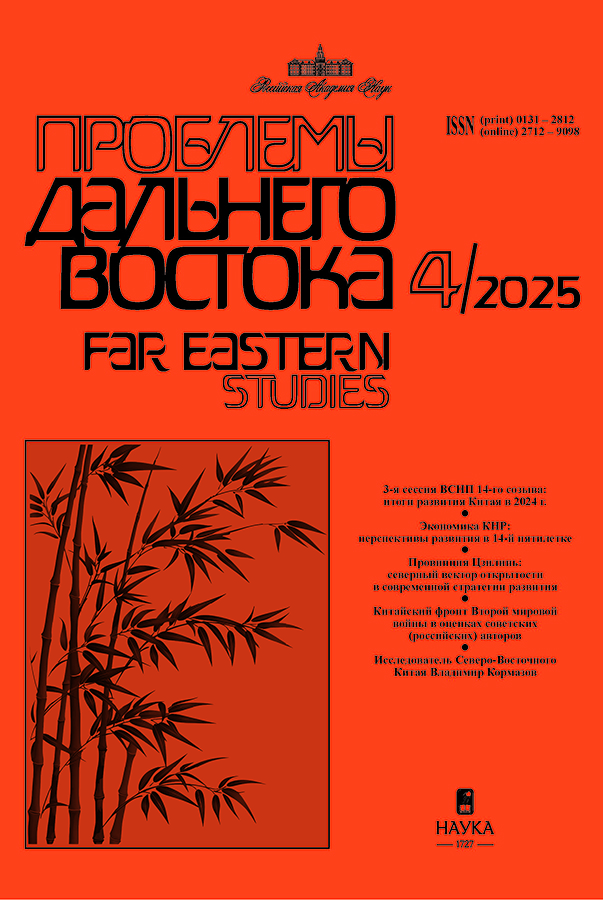History of Vaccination in China: Modern Stage
- Authors: Gerasimova T.G1
-
Affiliations:
- Institute of China and Contemporary Asia of the Russian Academy of Sciences
- Issue: No 5 (2024)
- Pages: 127-141
- Section: State and society
- URL: https://rjmseer.com/0131-2812/article/view/676263
- DOI: https://doi.org/10.31857/S0131281224050096
- ID: 676263
Cite item
Abstract
The history of vaccination in China is an unexamined area in research into the general history of Chinese healthcare, which, in turn, has also been little studied in Russian historical science. The article is devoted to the history of health care in the field of prevention of vaccinepreventable diseases in modern China. In the 21st century, in order to carry out a large-scale immunization program for the Chinese population, the fight against epidemics of infectious diseases required skill and talented political will to organize united actions of the Chinese authorities and society. Since the beginning of the century, during the implementation of the National Immunization Program in the PRC, the central government revised the existing legislation, adopted new laws, created a subsidized fund, the New Rural Cooperative Medical Scheme, and formed the National Advisory Committee on Immunization, whose tasks include comprehensive collection and evaluation of scientific data. China became one of the first countries to join the Global Alliance for Vaccines and Immunization. Based on the analysis of statistical data, the author shows that the development of preventive immunization in China ultimately not only improved the overall health of Chinese citizens, but also contributed to the progress of public health throughout the world. It is noted that the level and scale of domestic vaccine development play an indispensable role in the ability to respond to emergency situations. The PRC has made considerable efforts to strengthen its influence in various regions of the globe with the help of its vaccines. It is a great achievement that China is able to effectively develop its National Immunization Program, greatly increasing the speed and quality of vaccine development, as well as control measures for produced vaccines, both at the legislative and technological level, especially in connection with the COVID-19 pandemic. The article uses scientific research materials from Chinese and other foreign scientists published in monographs and scientific journals, as well as information from official Chinese sources.
Keywords
About the authors
T. G Gerasimova
Institute of China and Contemporary Asia of the Russian Academy of Sciences
Author for correspondence.
Email: gerta48@mail.ru
ORCID iD: 0009-0008-9693-7354
Senior Researcher, Centre for Contemporary History of China and its Relations with Russia
Moscow, Russian FederationReferences
- Haijun Zhang et al. Adding new childhood vaccines to China’s National Immunization Program: evidence, benefits, and priorities // Lancet Public Health. 2023. Vol. 8. Pp. e1016—e1024. doi: 10.1016/S2468-2667(23)00248-7
- Hao Yang, Hao Tan, Jintao Zhang, Mengying Yang. China's pivot from zero-COVID strategy and the role of vaccines // Health Policy and Technology. 2024. Vol. 13. Iss. 1. Article 100786. Pp. 1-8. doi: 10.1016/j.hlpt.2023.100786
- Haonan Zhang, Bryan Patenaude, Chao Ma, Hai Fang. Vaccine pricing strategies in China // BMJ Global Health. 2023. Vol. 8. Article e011405. Pp. 1-5. DOI: 10.1136/ bmjgh-2022-011405
- Huizhen Zheng et al. Epidemiological changes in measles infections in southern China between 2009 and 2016: a retrospective database analysis // BMC Infectious Diseases. 2020. Vol. 20. Article 197. Pp. 110. doi: 10.1186/s12879-020-4919-x
- Jiuling Li et al. Promoting higher-valent pediatric combination vaccines in China: challenges and recommendations for action // Infectious Diseases of Poverty. 2024. Vol. 13. Article 12. Pp. 1-11. doi: 10.1186/s40249-024-01181-9
- Marjan Mohamadi et al. COVID-19 Vaccination Strategy in China: A Case Study // Epidemiologia (Basel). 2021. Vol. 2. Iss. 3. Pp. 402-425. doi: 10.3390/epidemiologia2030030
- Shu Chen, Laiang Yao, Weibing Wang, Shenglan Tang. Developing an effective and sustainable national immunisation programme in China: issues and challenges // The Lancet Public Health. 2022. Vol. 7. Iss. 12. Pp. e1064-e1072. doi: 10.1016/S2468-2667(22)00171-2
- Su Qiru. Epidemiology of Measles in China, 2015-2016 // Chinese Journal of Vaccines and Immunization. 2018. Vol. 24. No. 2. Pp. 146-151.
- Wen Zheng et al. COVID-19 vaccination program in the mainland of China: a subnational descriptive analysis on target population size and current progress // Infectious Diseases of Poverty. 2021. Vol. 10. Article 124. Pp. 1-10. doi: 10.1186/s40249-021-00909-1
- Wenzhou Yu et al. Vaccine-preventable disease control in the People’s Republic of China: 1949-2016 // Vaccine. 2018. Vol. 36. Iss. 52. Pp. 8131-8137. doi: 10.1016/j.vaccine.2018.10.005
- Xiaodong Tan, Xiangxiang Liu, Haiyan Shao. Healthy China 2030: A Vision for Health Care // Value in Health Regional Issues. 2017. Vol. 12. Pp. 112-114. doi: 10.1016/j.vhri.2017.04.001
- Xiuli Wang, Yaru Fan, Wei Wang. Investigation of non-National Immunization Program vaccination intentions in rural areas of China // BMC Public Health. 2023. Vol. 23. Article 1485. Pp. 1-12. doi: 10.1186/s12889-023-16390-4
- Yaming Zheng et al. The landscape of vaccines in China: history, classification, supply, and price // BMC Infectious Diseases. 2018. Vol. 18. Article 502. Pp. 1-8. doi: 10.1186/s12879-018-3422-0
- Zhiming Huang, Zhihao Fu, Junzhi Wang. Review on Drug Regulatory Science Promoting COVID-19
- Vaccine Development in China // Engineering. 2022. Vol. 10. Pp. 127-132. doi: 10.1016/j.eng.2022.01.001
- 张颖等: 基于腺病毒载体技术平台的新型冠状病毒疫苗研发和应用进展 [Zhang Ying et al. Research and application of the SARS-CoV-2 vaccine based on adenovirus vector technology platform]. 中华预防医学杂志. 2023. 第57卷. 第7期. 第1082–1095 页. doi: 10.3760/cma.j.cn112150–20230419–00309. (In Chin.)
- 江永紅: 中國疫苗百年紀實 1919–2019 [Jiang Yonghong. China's hundred-year history of vaccination, 1919–2019]. 香港: 開明書店, 2021年. 513 页. (In Chin.)
Supplementary files











